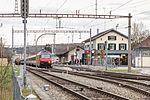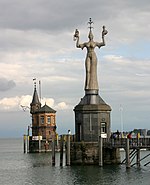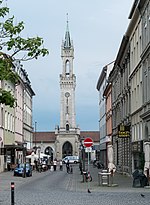Kurzrickenbach Seepark railway station
KreuzlingenPages with no open date in Infobox stationRailway stations in the canton of ThurgauSwiss Federal Railways stations

Kurzrickenbach Seepark railway station (German: Bahnhof Kurzrickenbach Seepark) is a railway station in Kreuzlingen, in the Swiss canton of Thurgau. It is an intermediate stop on the Lake line and is served as a request stop by local trains only. It is one of four stations within the municipality of Kreuzlingen.
Excerpt from the Wikipedia article Kurzrickenbach Seepark railway station (License: CC BY-SA 3.0, Authors, Images).Kurzrickenbach Seepark railway station
Bleichestrasse,
Geographical coordinates (GPS) Address Nearby Places Show on map
Geographical coordinates (GPS)
| Latitude | Longitude |
|---|---|
| N 47.643085 ° | E 9.19635 ° |
Address
Bleichestrasse
8280
Thurgau, Switzerland
Open on Google Maps








